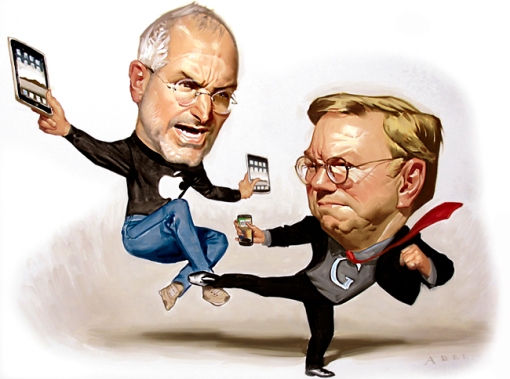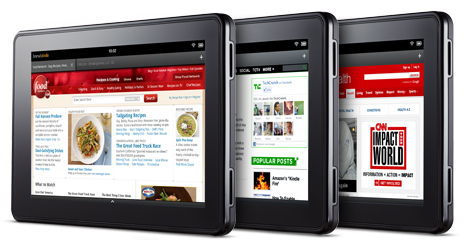
Wow, 3 (4 if you want to be technical) new Kindles in one day! The star of the show was no doubt the Kindle fire but all the models are noteworthy (to put it lightly). To keep things simple, I’m just going to give impressions and post the tech-specs down below. Let’s start from the bottom ($) and work our way up.
Kindle:

The $79.99 kindle was a marvelous play on amazon’s part. To get to this price point, amazon cut out the mic, speaker, GPS and touch and threw in some sponsored ads but this really shouldn’t be a problem for 80-90% of e-reader users. This price point also obliterates the second-tier e-reader market.
Kindle Touch/ Kindle Touch 3G
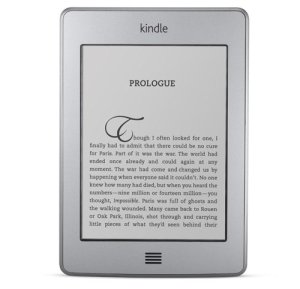
Stepping up from there we’ve got the kindle touch starting at $100 ($150 with 3G). Besides the keyboard , there really isn’t an advantage to the touch screen but if you upgrade to the 3G version you really get your money’s worth. I know this seems a bit backwards (How could throwing in $50 raise its value?) but you have to take into account the fact that you’re getting free data service for the life of the device: That’s access to any book from Amazon’s store as well as rudimentary internet browsing from basically anywhere you may find yourself… for 50 dollars more. You can’t beat that.
Kindle Fire 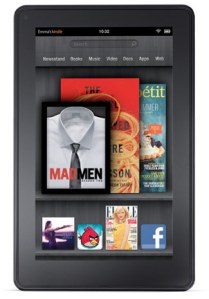
Now let’s get to the belle of the ball, the Kindle Fire. The first thing that comes to mind when looking at this device (unfortunately) is the Blackberry Playbook. And the similarities aren’t just cosmetic, the tech specs also give you a major case of Déjà vu. But don’t get me wrong; this isn’t going to be the flop that the Playbook was. The Fire has three killer features that the Playbook desperately needed: Amazon’s massive Ecosystem, Android, and Price.
- Ecosystem:
- Amazon has the most extensive ecosystem by far. They have more movies on demand (and better prices) than Apple, they practically own the e-books business, they can give Apple a run for its money in music sales and to top it all off they have the Amazon Appstore (not touching Apple, but more than sufficient). All of this means that you’ll never feel like you’re missing out on anything.
- Android:
- Let’s not forget that at its core this is an Android 2.3 Gingerbread tablet (not honeycomb interestingly). What that means for users is that you get access to Android’s app catalogue (the second most extensive app catalogue for tablets) while still maintaining a custom UI feel. Amazon has done a splendid job skinning the tablet to make it unique and stylish while keeping it functional thanks to Amazon’s vast media ecosystem. The Playbook on the other hand ran on QNX (Blackberry’s last hope of renewal), which didn’t have any notable apps, let alone the support that android has had. The game has changed from the days when Blackberry was king. Nowadays the app selection is practically as important as the hardware it’s running on and the Playbook isn’t getting any love from developers (and never did).
- Price:
- $200. Let me repeat that, $200!! That’s what you could expect to pay for a no name, half-baked, bargain bin tablet… and you’re getting a full-fledged android tablet. You’re paying $150+ less than you would for the entry-level playbook and you’re getting so much more. Just to add icing to this already delicious cake, Amazon Prime subscribers ($90 a year but totally worth it) get free access to their entire video on demand collection on top of free second day shipping. It’s not exactly hard to choose the winner here.
But Blackberry isn’t the only competition that should be sweating right now. Barnes and Noble can kiss its Nook Color “readers tablet” (a nice way to phrase “cheaply made and with terrible specs”) good-bye. The Fire is $50 cheaper, has more than double the horsepower, has much better build quality and absolutely obliterates the Color when it comes to media selection (apps, music, movies, e-books, etc.). Samsung’s 7-inch Galaxy tab is also going to find itself swimming with the fishes along with the HTC Flyer (talk about overpriced) and all other tablets sharing 7-inch form factor. The reason Amazon can afford such a low price is because it isn’t a tablet seller but an online store. Whenever you buy off the Amazon Android Appstore (mouthful!), kindle store, or directly from the Amazon store, they reap more and more profit. The actual device probably won’t earn them more than $10 if they are profiting at all.
Summary:
To summarize it all, Amazon may have just dealt a fatal blow to practically all e-book device makers and any tablet makers selling in the 7-inch form factor. There isn’t another company out there (besides Google perhaps) that can afford to do what amazon is doing while remaining afloat. All that being said though, I still can’t 100% recommend the Kindle Fire. There’s nothing wrong with it, It’s actually something the Vice President of Amazon Kindle said. According to the man with the long title, there’s a 10-inch version of the same tablet (hopefully with better specs) coming out soon-ish (probably Q1 or Q2 this upcoming fiscal year). For me, the extra screen real estate (along with a more storage, a Micro SD card slot and better specs) is easily worth another Benjamin or more so I would wait for that to come out. Because of the size and the fact that I haven’t used it personally, I can’t say that this is an iPad killer (at this point it isn’t even competing with the iPad) but it’s definitely has second-place wrapped up.
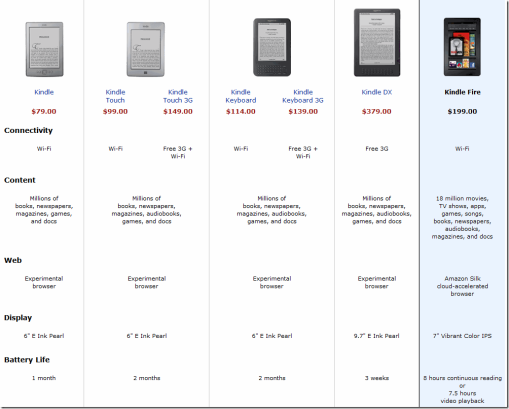

If you have any questions or want to share your personal opinion, feel free to comment below!

